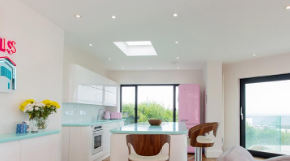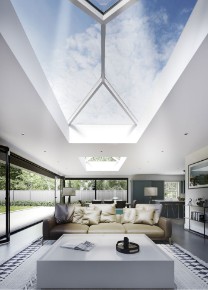If you’re thinking of replacing your skylight, you might be overloaded with questions of how to go about this. There are a few aspects to cover, but this guide should make you more confident in the decisions you make along the way.
Signs Your Skylight Needs Replacing or Repairing
Spotting if your skylight requires repair or replacement is essential. These are signs that your skylight might need repairing or replacing:
- Cracks in the glass
- Condensation between the panes
- Discoloration
- Leaking
- Whistling or draughts
- Dampness around the skylight area
- A skylight approaching or over 10 years old
- Upcoming roof replacement
If you notice any damage to the glass, repair or replace the component or unit as soon as possible to maintain your home's safety and the skylight's functionality.
Choosing the Right Skylight Replacement
Selecting the perfect replacement for your skylight involves a few key considerations to ensure you get the best fit for your home.
Firstly, the size of the existing hole is a limiting factor; it's essential to choose a skylight that aligns with this space unless you’re prepared for extensive modifications to accommodate a different-sized skylight.
Consider the style and material of the skylight, as these should complement your home's architecture and meet your preferences while ensuring functionality and durability.
When choosing your new skylight, factor in insulation properties, noise reduction capabilities, the appropriate size and angle for optimal light entry, and, of course, the cost. These considerations will help you in finding a skylight that not only improves the aesthetics of your home but also contributes to its energy efficiency and your comfort.
Preparing for Replacement
Before replacing your skylight, be sure to prepare the interior space. This might involve moving furniture away from the area, covering items to shield them from dust and debris, and ensuring the installation area is safe and accessible. Such measures will ensure a smoother replacement process, minimising disruption and protecting your belongings.
Additionally, provide clear access to the roof to ease the installation process. This step is essential for a straightforward and safe replacement, allowing the installers to work efficiently without obstacles.
DIY vs. Contractor
Our skylights are engineered for easy installation, making them a feasible option for those who are handy and confident in their DIY skills. However, if you have limited experience with roofing or DIY projects, considering a professional installation is a wise choice.
Going down the DIY route can save costs, but it comes with the risk of incorrect installation and the challenge of handling unexpected issues. On the other hand, hiring a contractor ensures expertise, efficiency, and peace of mind, particularly for larger units, which definitely require professional handling to guarantee safety and optimal installation.
How to Replace a Skylight
1. Remove the old skylight
To begin removing the old skylight:
- Safely access the roof and remove any debris or obstructions around the skylight.
- Carefully remove the flashing and any fasteners securing the skylight to the roof.
- Cut through the sealant or adhesive holding the skylight in place, being mindful not to damage the roof.
- Lift the old skylight out of the opening, ensuring that you have adequate help for larger units.
2. Prepare the new skylight and roof
Different skylights come with varying installation methods. For instance, larger skylights might require a mechanical lift for positioning, while installation can vary between using a builder's upstand to a PVC kerb. It's crucial to follow the specific instructions tailored to your skylight type.
- Check the roof opening to ensure it matches the dimensions of your new skylight, making adjustments if necessary.
- Ensure the roof edges and opening are clean, dry, and free from debris to secure a good seal.
- Install any required supports or frames, such as a builder's upstand or PVC kerb, according to the skylight's design.
- Apply appropriate sealants or adhesives as directed to prevent water ingress.
For detailed guidance, refer to our skylight installation video guides, which provide step-by-step instructions tailored to your specific skylight model.
3. Fit the new skylight
Once the kerb or upstand is prepared:
- Place the glass unit squarely on the upstand or kerb
- Use plastic packers to fill the gaps between the frame and upstand or kerb at screw holes
- Screw unit fasteners through the washers and plastic packers
- Fit snap caps over the head of each fastener
How to Choose an Installer
When looking for a skylight installer, ask for referrals, check online reviews and photos of projects they have completed. Confirm they have the necessary licenses and insurance. Ensure they have experience with your type of skylight and provide a detailed quote and timeline.
Choose an installer based on their expertise and positive feedback, not just price. They should demonstrate a strong track record with installations similar to yours.
Key Takeaways
To recap on the key points of replacing your skylight:
- Regularly check for signs like cracks, leaks and discolouration to determine if your skylight needs replacing.
- When choosing a replacement, consider factors like size, insulation, noise reduction, and cost.
- Avoid unwanted damage by preparing your space effectively.
- DIY installation is an option for those with experience, but professional installation is recommended for safety and efficiency, particularly for larger units.
- Select a reputable installer by seeking referrals, checking their credentials, and ensuring they have experience with your type of skylight.
Frequently Asked Questions
Can I replace skylights without replacing roof?
Yes, you can replace skylights without replacing the entire roof, especially if the roof is in good condition. The key is to ensure the new skylight fits properly and is sealed to prevent leaks.
How much does it cost to replace a skylight in the UK?
The cost to replace a skylight in the UK varies based on size and type of the skylight, as well as installation complexity, but it typically ranges from £300 to £1,500. This is in addition to the unit cost.
How much should a new skylight cost?
A new skylight's cost depends on its size, type, design and materials. On average, homeowners might spend between £500 and £3,000, considering factors like size, style, and any additional features.
Can you just replace the glass in a skylight?
Yes, it's possible to replace the glass in a skylight if the frame and surrounding structure are intact and in good condition. This can be a cost-effective option if the glass is the only component that's damaged.
What is the average lifespan of a skylight?
The average lifespan of a skylight is around 10 to 20 years, though this can vary based on the quality of materials, installation, and exposure to the elements. Regular maintenance can extend its longevity. We offer a 10-year manufacturer warranty on all of our products.
How often should skylights be replaced?
Skylights should be replaced every 10 to 20 years or sooner if there are signs of wear and tear like leaks, cracks or fogging between panes. Regular inspections can help identify the need for replacement.
















 Buy Now, Pay Later
Buy Now, Pay Later 